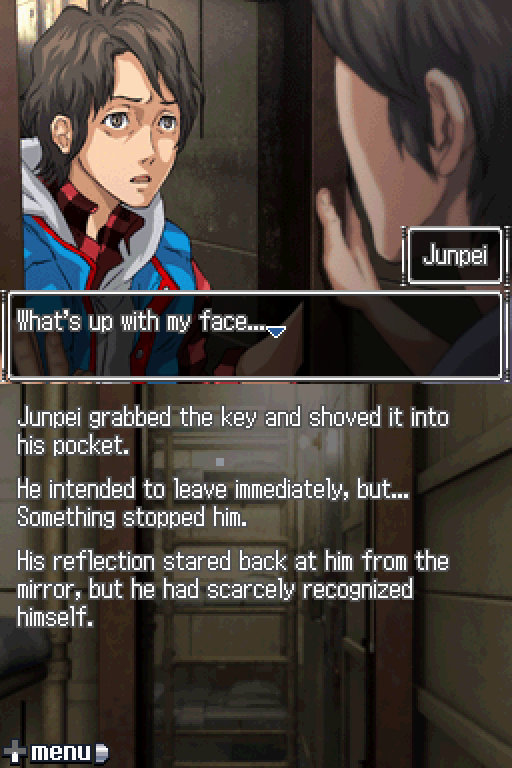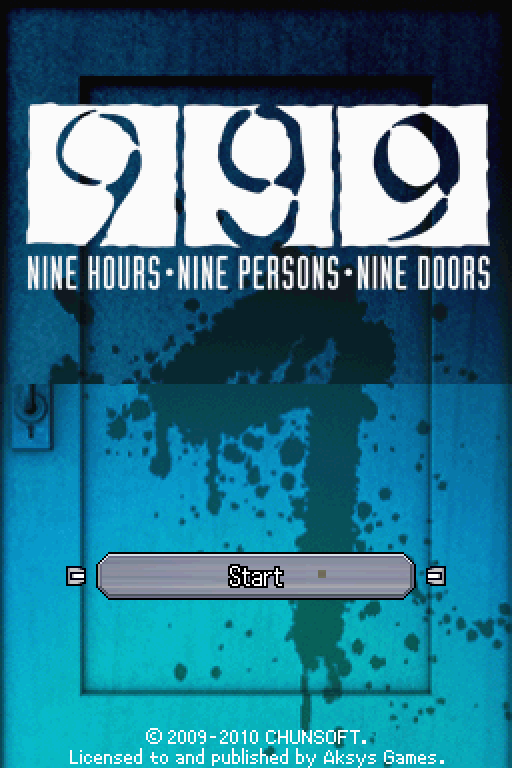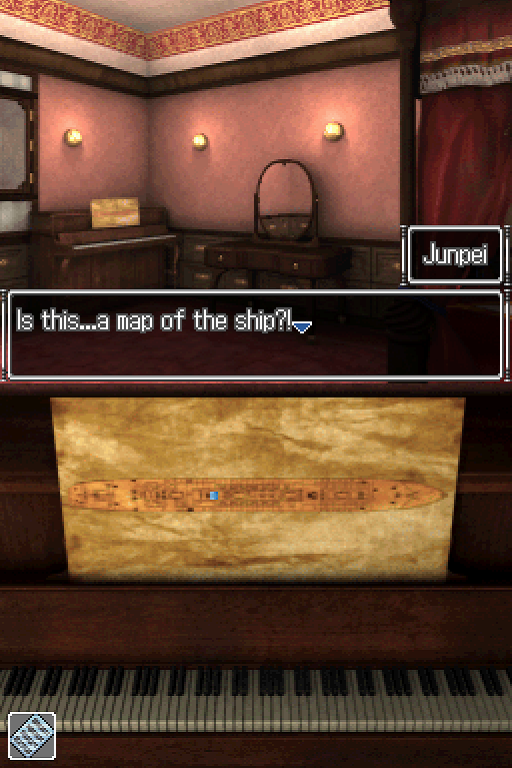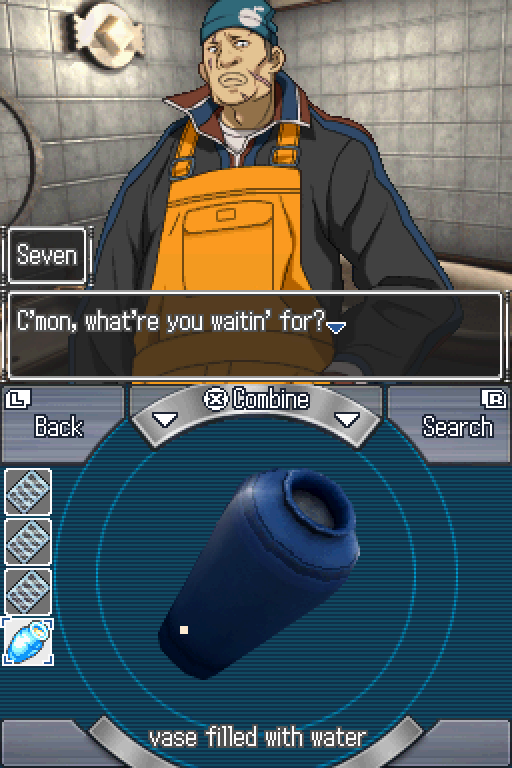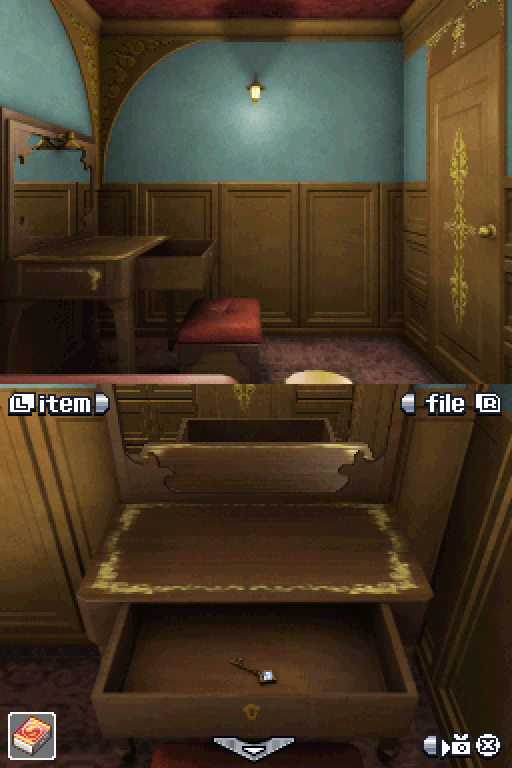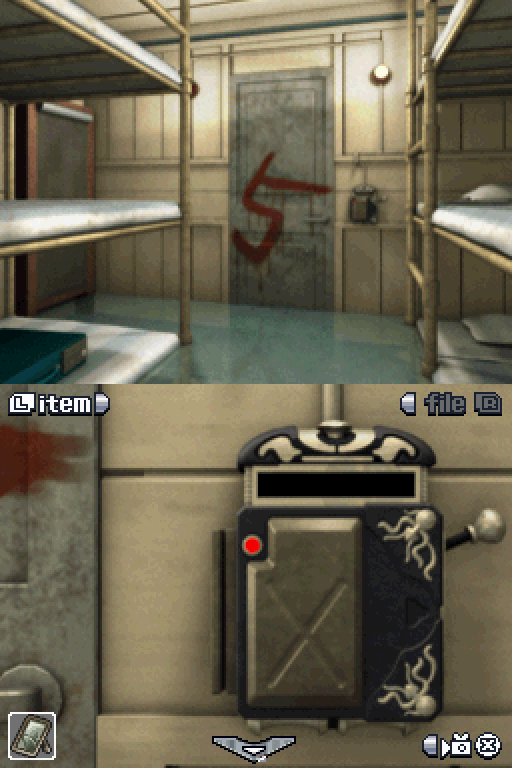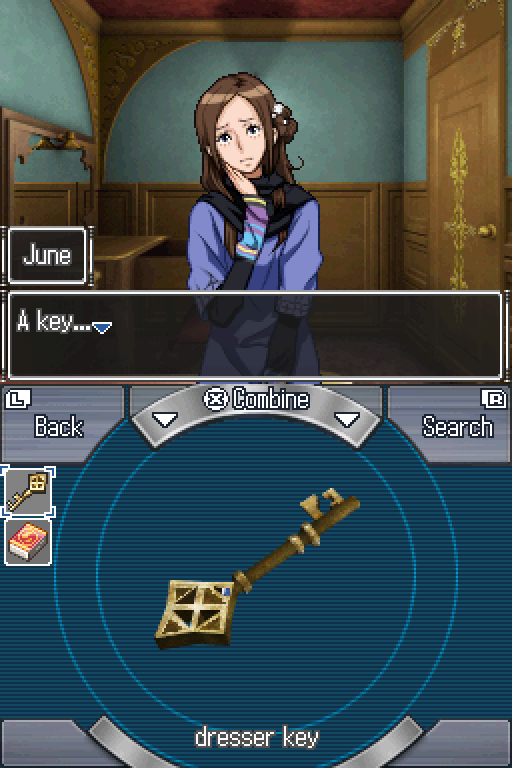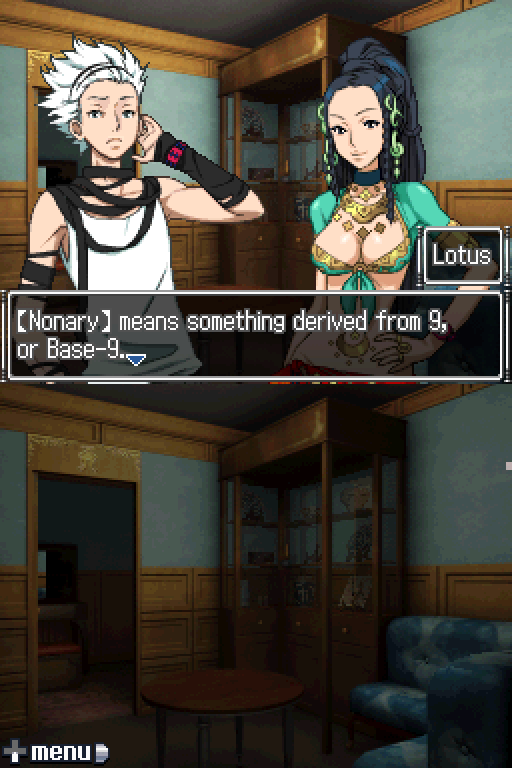NINE HOURS, NINE PERSONS, NINE DOORS (DS)
Nine Hours, Nine Persons, Nine Doors has to go down as one of the sleeper hits of its generation. Its unusual moniker alludes to an involved story centred on nine individuals who’ve been kidnapped and spirited away to a Titanic-like vessel. In turn, they must work together in order to best a sequence of fiendish puzzle scenarios set by the mysterious Zero, with the ultimate goal of escaping via a door displaying a ‘9’. And nine hours? That’s how long they have to succeed, before Zero floods the place, killing everyone. 999 is a rare treat; producing a narrative of considerable depth and cohesion, and mixing it with some excellent, cerebral puzzling to the point where, at times, it’s near-unputdownable.
Essentially a whodunnit, a kidnapping mystery and a group experiment all rolled into one, 999 grabs the player by scruff of the neck, involving you in the inevitable power struggles, alliances, friendships and betrayals you’d expect of a divergent group of strangers desperate to come to terms with their plight. It takes place from the Junpei, a young adult whom, after a breathless introduction, meets with eight others – seven of whom appear complete strangers, and one he recognises as a childhood friend. Each has been shackled with an electronic bracelet displaying a number between one and nine. Teams are then compelled to enter numbered doors – the combined total (or “digital root” combining individual digits if the total exceeds single-figures) of the bracelets must match the number on the doors in order to open them, leading to a variety of different outcomes dependent on your choices. Once through, there are some elaborate teasers and challenges to undertake as you aim to open up the ship’s labyrinth of locked areas. Tension is high, trust is in short supply, and the tale takes a turn for the macabre as the group soon discovers a body…
Essentially a whodunnit, a kidnapping mystery and a group experiment all rolled into one, 999 grabs the player by scruff of the neck, involving you in the inevitable power struggles, alliances, friendships and betrayals you’d expect of a divergent group of strangers desperate to come to terms with their plight. It takes place from the Junpei, a young adult whom, after a breathless introduction, meets with eight others – seven of whom appear complete strangers, and one he recognises as a childhood friend. Each has been shackled with an electronic bracelet displaying a number between one and nine. Teams are then compelled to enter numbered doors – the combined total (or “digital root” combining individual digits if the total exceeds single-figures) of the bracelets must match the number on the doors in order to open them, leading to a variety of different outcomes dependent on your choices. Once through, there are some elaborate teasers and challenges to undertake as you aim to open up the ship’s labyrinth of locked areas. Tension is high, trust is in short supply, and the tale takes a turn for the macabre as the group soon discovers a body…
999 has lots of story to wade through. Fortunately, it's an enthralling and intelligent yarn that will have you hooked
A palpably tense atmosphere emerges from the raft of moral ambiguities thrown up by the Nonary Game, and its fascinating sub-clauses. Bracelets can only be removed through successfully escaping or the wearer flat-lining, whilst we learn more sinisterly that the bracelet doesn’t necessarily have to be attached to their user in order to activate a numbered door. Not only did Chunsoft think it all through with astonishing thoroughness from a mathematical perspective, but they nailed how each little instance may be exploited, resulting in a zinger moment out the blue, and it’s a run of such instances that will keep the player positively welded to their DS.
Comprising of little more than static backgrounds and simple effects, it’s remarkable how successfully 999 drags you into its deliciously murky, uneasy atmosphere. With characters playing their cards close to their chests, you’re never quite sure of who to trust, and what the unearthing of snippets of information, conjecture and back-story means in the bigger picture. Deaths hit with profound effect, and with a myriad of ‘bad’ endings to stumble across before the true finale, it evokes a tangible sinking feeling as things start to unravel. 999 isn’t cheesy though; authentically modern dialogues side-step most of the personality clichés Japanese storytelling has fallen foul of in recent times, whilst unflinching accounts of shocking events lend it a much heavier tone than other DS graphic adventures. Don’t let the animation and general bright veneer fool you: 999 is a visceral, gut-wrenching experience, and it is easy to forget that it’s all achieved through the magnetism of its storytelling.
Comprising of little more than static backgrounds and simple effects, it’s remarkable how successfully 999 drags you into its deliciously murky, uneasy atmosphere. With characters playing their cards close to their chests, you’re never quite sure of who to trust, and what the unearthing of snippets of information, conjecture and back-story means in the bigger picture. Deaths hit with profound effect, and with a myriad of ‘bad’ endings to stumble across before the true finale, it evokes a tangible sinking feeling as things start to unravel. 999 isn’t cheesy though; authentically modern dialogues side-step most of the personality clichés Japanese storytelling has fallen foul of in recent times, whilst unflinching accounts of shocking events lend it a much heavier tone than other DS graphic adventures. Don’t let the animation and general bright veneer fool you: 999 is a visceral, gut-wrenching experience, and it is easy to forget that it’s all achieved through the magnetism of its storytelling.
Well, nearly all. That would be doing a disservice to the music which, when not treading the restful ditties of puzzle rooms, is steadfastly massaging the undercurrents of paranoia that form a backdrop to the many character/group interactions, gradually instilling a sensation of doom that becomes synonymous with the (usually unwelcome) surprises that lie in wait. It’s very well presented, using the top-screen for map and environment details, and the touch screen for examining clue rooms and reading dialogue. Importantly, as well as offering pleasantly different experiences, each puzzle room is highly detailed and yet not over-cluttered. Objects and general points of interaction are rarely overly obscure, whilst picture clarity is never an issue either – a potential stumbling block that has diminished DS puzzlers in the past. The anime-style characters really look the business, and even the Phoenix Wright-style 3D analysis of items looks (and performs) great.
A majority of your time will be spent reading through the story, but 999 fairs particularly well in its puzzle sequences too. Whilst a good deal of success is to be found in the familiar manner of combing over the detailed surrounds looking for key items, there’s a glut of logic puzzles, cryptic teasers and item combinations that would have made Resident Evil proud in its survival horror heyday. There’s cabins, casinos, a bridge, a cargo hold, a sinister lab. And the differences aren’t just for window dressing either, most offer involved, diverse puzzles that can prove real tough nuts to crack.
A majority of your time will be spent reading through the story, but 999 fairs particularly well in its puzzle sequences too. Whilst a good deal of success is to be found in the familiar manner of combing over the detailed surrounds looking for key items, there’s a glut of logic puzzles, cryptic teasers and item combinations that would have made Resident Evil proud in its survival horror heyday. There’s cabins, casinos, a bridge, a cargo hold, a sinister lab. And the differences aren’t just for window dressing either, most offer involved, diverse puzzles that can prove real tough nuts to crack.
The escape rooms make intuitive use of the stylus, posing some fun and taxing challenges
There are just a couple of small grievances with regards to return playthroughs. Whilst its successor Virtue’s Last Reward gives the player the option to return to a specific, earlier branching point in the story so as to pursue an alternative outcome, 999 sees you having to make a full run each time you want to affect a change. In fairness, there is a speed-skip option for text you’ve already read in an earlier playthrough, and the game rather smartly slows dialogue down again when it reaches a previously unseen section, but it does mean having to do the same puzzle rooms (particularly the earlier ones) multiple times over. Likewise, hints on how to go about getting the ‘full’ ending are a bit sketchy and dependent on a couple of seemingly-innocuous dialogue decisions.
Story articulation is clear and, whilst not always concise, the protagonists are truly interesting individuals and, with no one among the nine feeling like they’re there to make up the numbers, each is relatable in their own way. The game keeps you guessing as to the identities of the murderer and Zero until late on. The full, final ending is a tiny bit disappointing, though this may be the sensation brought about by expecting so much from a game that delivers so many unexpected, satisfying twists, with such frequency throughout.
Nine Hours, Nine Persons, Nine Doors represents something of a renaissance for Japanese graphic adventures, working to unexpectedly brilliant effect in portable format. As a puzzler it emits a refreshing level of cunning and intelligence in design, whilst its story’s mature themes, fascinating premise and excellent realisation make it akin to a good book, one that you can dive into at-leisure. An absolute must for DS owners.
Story articulation is clear and, whilst not always concise, the protagonists are truly interesting individuals and, with no one among the nine feeling like they’re there to make up the numbers, each is relatable in their own way. The game keeps you guessing as to the identities of the murderer and Zero until late on. The full, final ending is a tiny bit disappointing, though this may be the sensation brought about by expecting so much from a game that delivers so many unexpected, satisfying twists, with such frequency throughout.
Nine Hours, Nine Persons, Nine Doors represents something of a renaissance for Japanese graphic adventures, working to unexpectedly brilliant effect in portable format. As a puzzler it emits a refreshing level of cunning and intelligence in design, whilst its story’s mature themes, fascinating premise and excellent realisation make it akin to a good book, one that you can dive into at-leisure. An absolute must for DS owners.
|
|
VERDICT
Visual: 8/10
Audio: 8/10 Gameplay: 8/10 Longevity: 7/10 OVERALL: 8/10 |
PIXEL SECONDS: NINE HOURS, NINE PERSONS, NINE DOORS (DS)
Nine Hours, Nine Persons, Nine Doors is a fascinating, absorbing adventure that’s rife with tension and unease. Junpei wakes up inside a cabin, and after escaping an immediately intense situation, he soon meets up with several other individuals, all of whom have similarly been kidnapped and trapped on this ship with numbered bracelets attached to their arms. Part of a dangerous game set up by the mysterious Zero, doors must be unlocked using the aforementioned bracelets and fiendish tests must be solved in order to escape before a nine-hour deadline. Soon, it becomes clear this game has a tendency to descend into murder, with a tense moment exploding into a gruesome sequence highlighting the consequence of breaking rules. This meticulous level of detail makes seeing the quirks of this game play out very enjoyable, with multiple endings depending on your choices. It helps that the cast of characters prove genuine, thought-out and likeable. 999 often reads like a good book, with plentiful text dialogue that utilises both screens very well. Writing is generally very strong, seeing each character talk with a distinctive tone, clear attitude and unique quirks conveyed through both spoken words and narration. It admittedly lacks conciseness at points and this can prove counter-productive to the scenario. Puzzles contained in Escape Rooms can be incredibly inventive, relying on mathematical equations, combining items and deciphering logic puzzles. All this is bolstered by intricate spritework, detailed backdrops and an outstanding soundtrack that balances melancholy, terror and ambience to key story moments. This mystery hooks you and refuses to let go, even through incredibly dark moments. An adept scenario, enjoyable characters and an intricate mystery waits for those with the patience to wade through lots of text and a couple of frustrations. [8] – Shane Battams © 2023
Nine Hours, Nine Persons, Nine Doors is a fascinating, absorbing adventure that’s rife with tension and unease. Junpei wakes up inside a cabin, and after escaping an immediately intense situation, he soon meets up with several other individuals, all of whom have similarly been kidnapped and trapped on this ship with numbered bracelets attached to their arms. Part of a dangerous game set up by the mysterious Zero, doors must be unlocked using the aforementioned bracelets and fiendish tests must be solved in order to escape before a nine-hour deadline. Soon, it becomes clear this game has a tendency to descend into murder, with a tense moment exploding into a gruesome sequence highlighting the consequence of breaking rules. This meticulous level of detail makes seeing the quirks of this game play out very enjoyable, with multiple endings depending on your choices. It helps that the cast of characters prove genuine, thought-out and likeable. 999 often reads like a good book, with plentiful text dialogue that utilises both screens very well. Writing is generally very strong, seeing each character talk with a distinctive tone, clear attitude and unique quirks conveyed through both spoken words and narration. It admittedly lacks conciseness at points and this can prove counter-productive to the scenario. Puzzles contained in Escape Rooms can be incredibly inventive, relying on mathematical equations, combining items and deciphering logic puzzles. All this is bolstered by intricate spritework, detailed backdrops and an outstanding soundtrack that balances melancholy, terror and ambience to key story moments. This mystery hooks you and refuses to let go, even through incredibly dark moments. An adept scenario, enjoyable characters and an intricate mystery waits for those with the patience to wade through lots of text and a couple of frustrations. [8] – Shane Battams © 2023
OTHER FIENDISH NARRATIVE PUZZLE GAME REVIEWS

